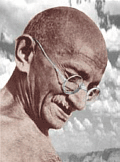 |
|

As
a method of satyagraha or Gandhian-style, non-violent direct
action, the padyatra has been used in India many times in
the past. Gandhi initiated the salt satyagraha in India, in
the 1930s, when he undertook a padyatra through Western India,
rallying people to break the British Salt Law, boycott salt
produced by the British, and make their own rock salt. Gandhi
couched the padyatra in cultural and religious terms that
made sense to the common people. Many other examples can be
cited in post-independent India to show the effective use
of the padyatra as a method of "fighting non-violently"
for justice, for and with people who are otherwise powerless.
A padyatra consists typically of a group of activists walking
from village to village or town to town, holding meetings
about an issue, inviting people to join in and take up solidarity
and protest actions, devising ways of working together to
advocate for progressive social change.
A padyatra thus helps to directly mobilize millions at the
grassroots and brings together like-minded civil society organizations
(CSOs), non-government organizations (NGOs), community groups
and networks. It produces some concrete images and hard facts
on the condition of disempowered people, while simultaneously
mobilizing and working with them. The "evidence"
gathered can then be used for advocacy, for e.g., to lobby
the government to change policy or implement an already existing
policy. A padyatra helps to harness media attention and create
public awareness and discussion about an issue. It takes the
work already done forward and produces many ripple effects.
In 1999-2000, the Ekta Parishad, effectively employed the
padyatra method in Madhya Pradesh (MP), to bring attention
to the plight of the poor and landless dalits and tribals
in this state. Following the MP padyatra, the state government
set up land commissions in approximately 40 districts of the
state, to review land claims.
Some Links on Gandhi:
web.mahatma.org.in
www.gandhiinstitue.org
...back
|

